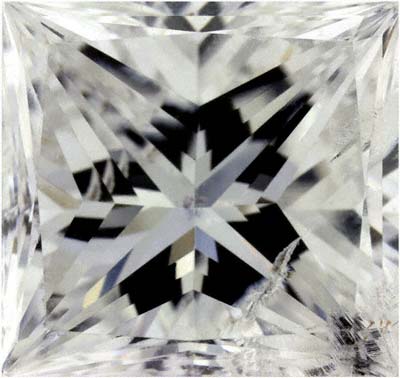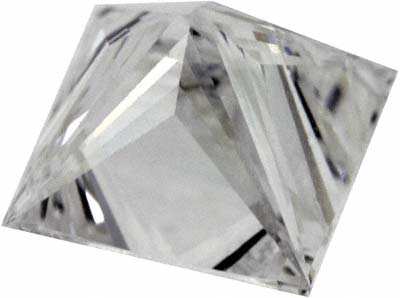| The Very Highest Quality Diamond Information... |
| Princess Cut Diamonds |

|
|
|

|
|
|

|
|
|

|
|
|
History of the Princess Cut
The Barion cut was the forerunner of the princess cut. This was a style of cutting for square or rectangular stones, with extra and improved facetting, so as to obtain maximum brilliance from the diamond. It was invented about 30 years ago by Basil Watermeyer from Johannesburg. We believe that the barion cut, and variations on it, have been the subject of patents, which have restricted the availability of the cut for a quarter of a century. It would seem that a number of these patents have expired within th past ten years, and this has led to the greater availability of similarly cut stones, so that any stones cut in a similar style are now known as princess cuts, and the princess cut has become a generic style of cutting.
Advantages of the Princess Cut
Some rough diamonds lend themselves more readily to be cut into a shape other than round. Whenever this occurs, the cutter must decide which shape will make the most attractive finished diamond, and be worth the most money. Most rough stones which suggest a square final shape would be best cut into princess cuts rather than step-cut square baguettes of square emerald cuts. This is particularly so if the rough stone is quite deep, because the princess cut works best with deep stones. This allows the maximum weight retention, and lowers the final cost per carat.
Square stones are better for certain design applications, such as eternity rings, as they can be set in one continuous line with no gaps between them such as would occur with round stones.
More Sparkle
Because of the extra facetting, and the effects it produces, princess cuts are naturally more brilliant and sparkly than ordinary square diamonds. Any inclusions are less visible, and any slight yellowish or brownish colour is less noticeable, helping to create more attractive diamonds at more reasonable prices.
Limitations of The Princess Cut
Princess cutting does not work well with shallow stones, but this causes no problems. It is also best with stones which are square or only slightly oblong for the same reason that round diamonds look better than oval ones. The reasons can be shown using mathematics and physics, and can be understood or guessed at by anyone with a modest knowledge of the properties of light. Longer thinner oblongs are therefore still fashioned into emerald cuts or baguette cuts.
Any sharp point on any diamond or other gemstone is a potentially vulnerable point, and the four corner angles of princess cut stones are no exception. For this reason, it is best if the jewellery mount is designed in such a manner as to protect the points. The greatest danger to most diamonds is when they are being set, as it is usually necessary to apply some force to the most delicate parts of the stone, for example the corners. All jewellery manufacturers experience this, and factor it into their costs when setting stones. Any damage done in setting can usually be repaired by re-polishing the stone, but this costs money, adds delay, and always results in at least a small weight loss. This is of course true for any diamonds or other stones, but tends to be slightly worse for stones with points or corners.
Not Just for Diamonds
The advantages of princess cut are not restricted purely to diamonds, it can be used on many other gemstones. One of our photographs shows an eternity ring set with princess cut rubies and princess cut diamonds.
The princess cut will obviously work best with lighter coloured transparent stones. Any stones which are opaque or dark will not benefit as much, if at all.
The Profile Cut
According to Harold Newman's "Illustrated Dictionary of Jewelry", the term princess cut was previously applied to what is now known as the profile cut. This is used for very flat diamonds. A series of "V" shaped grooves are cut into the back of a flattish stone, the top being polished. Often there is border which is facetted in different shaped facets, and the overall stone shape can be any shape such as round, heart, oval, square or fancy. This cut was developed by Arpad Nagy of London in 1961. Some diamond "experts" incorrectly allocate the invention of what is now known as the princess cut to Nagy, not realising that his princess cut is what we know as a profile cut.
Future Developments of the Princess Cut
We believe that variations of the princess cut will be developed with the corners cut in the manner of the emerald cut. This may be an advantage in helping the reduce the possibility of damage at the right-angled corners, and may well be an important development particularly for larger stones for use as solitaires. It would not really be an advantage in most eternity rings, as it would reintroduce a greater gap between the stones.
Since writing this page, the radiant cut has become more widely available.
Princess Cut Diamond Solitaire Rings For Sale
Perfect Princess Cut Diamonds For Sale
D colour, flawless, certificated unmounted princess cut diamonds.
More About Cut & Shape of Diamonds
| ...at the Lowest Possible Price |
|
32 - 36 Harrowside, Blackpool, Lancashire, FY4 1RJ, England. Telephone (44) - (0) 1253 - 343081 ; Fax 408058; E-mail: The URL for our main page is: https://24carat.co.uk | Chard(1964) Ltd |